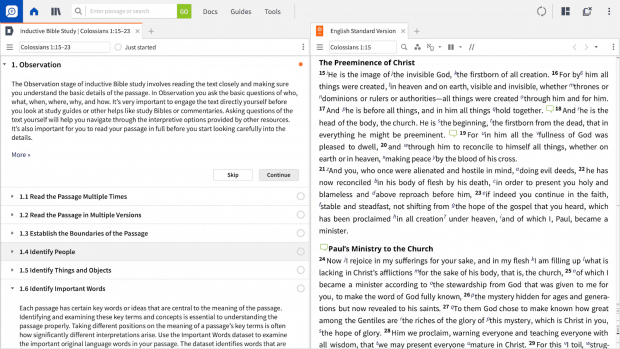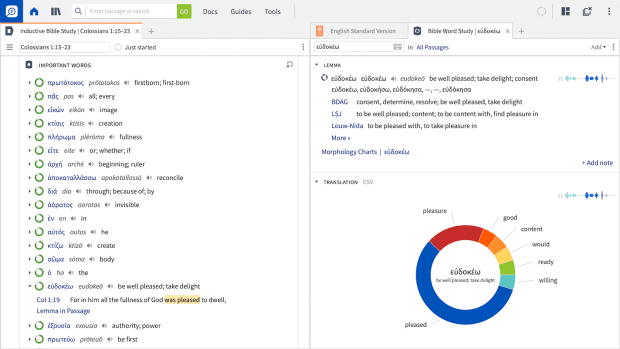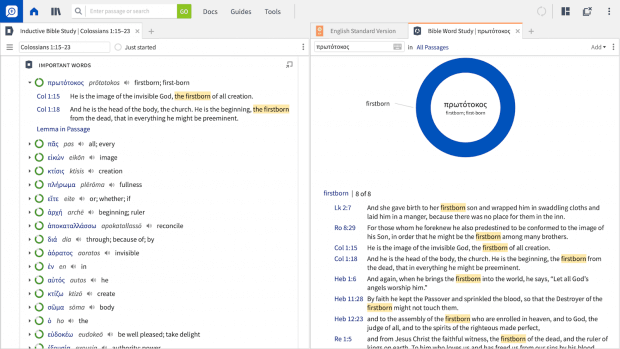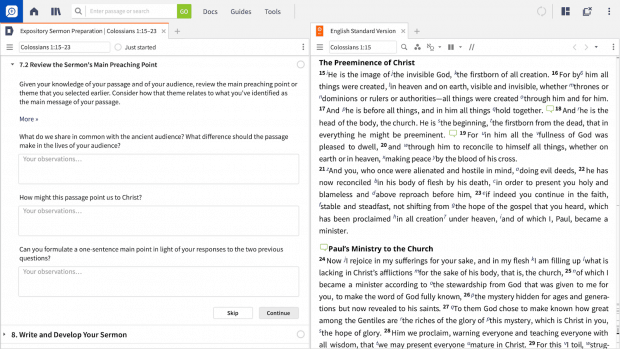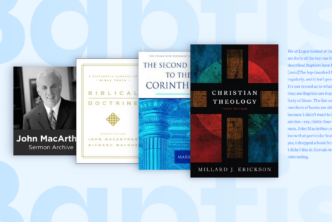A few years ago, I wrote a few segments for a popular Bible study. I loved every little bit of the research and thinking and writing, but I was relying on a stack of books about half my height (which isn’t saying much—I’m not a tall woman). The real issue was figuring out which books to pack for a family vacation right before the assignment was due.
Let me just tell you . . . my current self really wishes she could pass on her Logos knowledge to her past self. I didn’t know how Logos could help me in my role as a church staffer, a ministry volunteer, and a part-time seminary student.
Today, I want to show you four things I wish I knew Logos could do years ago. If this is your first introduction to Logos, a simple explanation: Logos is software you can download to your computer or mobile devices that combines resources (Bibles, books, courses, and more) with specific tools built to help you understand God’s Word more thoroughly.
Keep reading to learn more about a few tools in Logos and how they can enrich your time in God’s Word, fuel your ministry, and encourage healthy Bible intake habits.
1. Do inductive Bible study
It’s easy to skip through a Bible passage and jump to personal application before we’ve really spent time exploring what God is saying. Inductive Bible study is one of the best methods to help us slow down and see what Scripture means, how its earliest audience understood it, and how it should change our lives.
In Logos, you don’t need a workbook or a small group to go through an inductive Bible study. You don’t even need to pull Strong’s Concordance off your shelf. Everything you need is contained in a guided study in Logos (the Inductive Bible Study Workflow).
Once you open the Inductive Bible Study Workflow, simply choose the passage you want to study, and Logos guides you through the inductive method.
Let’s say we’re studying Colossians 1:15–23. Here’s how the Inductive Bible Study Workflow starts off:
You can do the entire study at once or bits each day, picking up where you left off. Logos saves your progress, and you can easily go back and see what you did.
As you fill in the boxes in the workflow, Logos saves each one as a note—and they stick to the passage you studied. That means anytime you return to that passage, you can easily click through the insights you found in your previous study.
Learn more about workflows in Logos.
2. Research words used in Scripture
Tracing repeated words in the Bible gives us a fuller picture of what the human authors intended. Thankfully, you don’t have to know Scripture’s original languages to be able to find these two key things about biblical words:
- Where the Greek or Hebrew word appears in other passages
- How the Greek or Hebrew word was translated in those other spots
Since we’re in Colossians 1:15–23, let’s look at the phrase “pleased to dwell” in verse 19. In the Important Words section of the Inductive Bible Study Workflow, we see eudokeō, which is translated “be well pleased; take delight.” When I click on the Greek word, this tab opens:
That’s the Bible Word Study in Logos, and it shows you every place where that Greek word is used in the New Testament and how it’s translated in each spot. When you scroll down, you can see related words, examples of where it’s used, and more. For now, we want to look at the translation section—that’s the one with the big wheel.
In the top corner of that section, we can see there are 21 uses of the word in the New Testament. Each color on the wheel breaks down those 21 uses by their translation—you can quickly see that “pleased” is the most common way it’s translated, but “delight” is in there, too.
If we click on the Greek word in the middle of the wheel, we can see the entire list of verses where the word appears, sorted by the English translation.
3. Find explanations for difficult passages
Now that we’ve done a simple word study, let’s say we want to dig deeper into verse 15: What does it mean that Jesus is the “firstborn of all creation”?
Again, in the Important Words section of the Inductive Bible Study Workflow, we see a Greek word translated as “firstborn.” If we click on prōtotokos, it opens the Bible Word Study tab, and we can see the word is used eight times in the New Testament. It’s always translated “firstborn”—which doesn’t really answer our question yet. Scrolling down, we see the Greek roots of the word, which give us a hint about what the phrase might mean.
Let’s make a note: the prōtos part of the word could refer to “birthright,” or it could refer to “be first” or “place of honor.” We can then click on the Greek word in the middle of the circle (prōtotokos) to see all eight places where the word appears in the New Testament.
We’re starting to form some ideas about what it means that Jesus is the “firstborn of all creation,” but let’s see what else we can learn.
As we continue through the Inductive Bible Study Workflow, we get to the Examine Commentary Discussions section.
We have a list of commentaries (it pulls from the commentaries currently in our library), and when we click through, they go straight to the passage we’re studying. The first three commentaries on this list supply these insights:
The context forbids any interpretation of these words that makes Christ first among created beings. . . . The simplest explanation is the best; the ‘first-born’ son was always the father’s heir. God’s Son, Jesus Christ, is ‘heir of all things’ as the corresponding passage in Hebrews plainly says (Heb 1:2).1
The NIV translation correctly states that Jesus is “over all creation.” The term “firstborn” distances Jesus from creation rather than subsumes him under it. Therefore, the point is that Jesus is the firstborn (preeminent) with reference to the creation, just as later Paul argued that Jesus was preeminent “out of the dead.”2
The title ‘firstborn’ . . . therefore conveys the idea of priority in both time and rank, and we should not foreclose on either of these options (NIV, in its paraphrase, allows only the idea of rank): to opt for temporal priority does not imply that the pre-existent Son of God is merely the first created being. The continuing temporal sense of the word is clear from verse 18 (cf. Rom. 8:29), and gives a parallel idea to that expressed in the NEB translation of John 1:1, ‘When all things began, the Word already was’. It is in virtue of this eternal pre-existence that the Son of God holds supreme rank.3
So, putting it all together, we can form the hypothesis that Paul, in Colossians 1:15, is using a familial term to explain how Jesus is over creation. Not only did he exist before creation, but he is superior to all of creation.
The best part: we found all this info without leaving the inductive Bible study we were already doing.
4. Plan and prepare lessons
What if you’re preparing for a small group or Bible study lesson instead of a personal study? Logos guides you through that as well.
If you were teaching on Colossians 1:15–23, you could go through the Expository Sermon Preparation Workflow to explore the passage from a teaching perspective. This workflow takes you through many of the same steps as the Inductive Bible Study Workflow, but it adds some steps that help you identify the passage’s main point and organize your thoughts.
By the time you’ve finished the workflow, you will have identified the main point, settled on the lesson outline, and written out the entire lesson—including illustrations and application points.
See how workflows make lesson (and sermon) prep easier.
How to get started with Logos
If these four Logos tools have piqued your interest and you’re ready to explore Logos yourself so you can do more in-depth Bible study, where should you begin?
Well, you have a few options:
- Take this short quiz
- Explore tradition-based packages (browse packages curated for a wide range of Christians)
- Start with Logos Silver
You could do well with any Logos package—truly.
But I recommend starting with Logos Silver because it unlocks every Logos tool (including over a dozen workflows, the Theology Guide, and even a Mobile Ed course of your choice). It also gets you nearly $5,000 worth of commentaries, Bible dictionaries, and other books for around 15% of what you’d pay if you bought each book separately.
And with adjustable payment plans, you can get a package that helps you study Scripture thoroughly at a price that won’t bust your budget.
Choose your Logos package today!
- R. C. Lucas, Fullness & Freedom: The Message of Colossians & Philemon, The Bible Speaks Today (Downers Grove, IL: InterVarsity Press, 1980), 50–51.
- Richard R. Melick, Philippians, Colossians, Philemon, vol. 32, The New American Commentary (Nashville: Broadman & Holman Publishers, 1991), 217.
- N. T. Wright, Colossians and Philemon: An Introduction and Commentary, vol. 12, Tyndale New Testament Commentaries (Downers Grove, IL: InterVarsity Press, 1986), 75.


